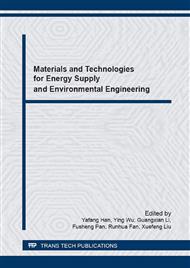p.472
p.479
p.485
p.490
p.497
p.505
p.510
p.519
p.527
Research of Nanosilica Particles Grafted with Functional Polymer Used as Fluid Loss Additive for Cementing under Ultra-High Temperature
Abstract:
On account of that the domestic polymer fluid loss additive exists some severe problems, such as, inferior thermal resistance, poor salt tolerance, strong shear-and thermal thinning behavior, a novel polymer/silica nanocomposite PADMO-V@NS is used as ultra-high temperature fluid loss control additive for cementing. In the present study PADMO-V@NS was prepared through an in situ free radical copolymerization of 2-acrylamico-2-methylpropane sulfonic acid (AMPS), N,N-dimethylacryl amide (DMAM), maleic anhydride (MA), octadecyl dimethylallyl ammonium chloride (ODAAC) and triethoxyvinylsilane (VTS) modified nanosilica. The linear hydrophobic associated copolymer was regarded as the shell and the modified nanosilica as the core. The microstructure, compositions and thermal resistance of PADMO-V@NS were investigated through FTIR and TGA techniques. The results showed that the copolymer modified with nanosilica particles possessed more excellent thermal stability than that of PADMO, and the most rapid decomposing temperature of PADMO-V@NS was highly up to 396.9°C. The application performance of PADMO-V@NS in cement slurry exhibited that it had excellent fluid loss control capacity, good high temperature resistance, strong salt tolerance and mild shear-/ thermal thinning performance, and could be used in 220°C and saturated brine circumstances. Moreover, comparing to PADMO, the compressive strength of set cement containing the copolymer increased over 20 % at 80°C, atmosphere pressure and curing time of 1 day due to the reaction of residual silanol groups with Ca (OH)2. The laboratory research results indicated that the multi-functional fluid loss additive composed of hydrophobic associated polymer/silica nanocomposite had bestowed on the cement slurry systems good comprehensive properties, and may have extensive applications in deep & ultra-deep oil/gas wells cementing.
Info:
Periodical:
Pages:
497-504
Citation:
Online since:
March 2016
Authors:
Price:
Сopyright:
© 2016 Trans Tech Publications Ltd. All Rights Reserved
Share:
Citation:


